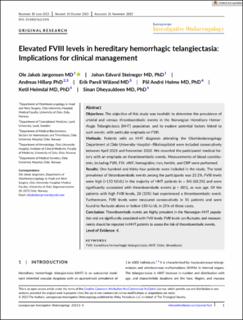| dc.contributor.author | Jørgensen, Ole Jakob | |
| dc.contributor.author | Steineger, Johan Edvard | |
| dc.contributor.author | Hillarp, Andreas | |
| dc.contributor.author | Wåland, Erik Pareli | |
| dc.contributor.author | Holme, Pål Andre | |
| dc.contributor.author | Heimdal, Ketil Riddervold | |
| dc.contributor.author | Dheyauldeen, Sinan Ahmed Dheyauldeen | |
| dc.date.accessioned | 2023-12-15T09:57:23Z | |
| dc.date.available | 2023-12-15T09:57:23Z | |
| dc.date.created | 2023-12-14T15:08:26Z | |
| dc.date.issued | 2023 | |
| dc.identifier.issn | 2378-8038 | |
| dc.identifier.uri | https://hdl.handle.net/11250/3107733 | |
| dc.description.abstract | Objectives: The objective of this study was twofold: to determine the prevalence of arterial and venous thromboembolic events in the Norwegian Hereditary Hemor- rhagic Telangiectasia (HHT) population, and to explore potential factors linked to such events, with particular emphasis on FVIII.
Methods: Patients with an HHT diagnosis attending the Otorhinolaryngology Department at Oslo University Hospital—Rikshospitalet were included consecutively between April 2021 and November 2022. We recorded the participants' medical his- tory with an emphasis on thromboembolic events. Measurements of blood constitu- ents, including FVIII, FIX, vWF, hemoglobin, iron, ferritin, and CRP were performed. Results: One hundred and thirty-four patients were included in the study. The total prevalence of thromboembolic events among the participants was 23.1%. FVIII levels were high (>150 IU/dL) in the majority of HHT patients (n = 84) (68.3%) and were significantly associated with thromboembolic events (p < .001), as was age. Of the patients with high FVIII levels, 28 (33%) had experienced a thromboembolic event. Furthermore, FVIII levels were measured consecutively in 51 patients and were found to fluctuate above or below 150 IU/dL in 25% of these cases.
Conclusion: Thromboembolic events are highly prevalent in the Norwegian HHT popula- tion and are significantly associated with FVIII levels. FVIII levels can fluctuate, and measure- ments should be repeated in HHT patients to assess the risk of thromboembolic events. Level of Evidence: 4. | en_US |
| dc.language.iso | eng | en_US |
| dc.rights | Attribution-NonCommercial-NoDerivatives 4.0 Internasjonal | * |
| dc.rights.uri | http://creativecommons.org/licenses/by-nc-nd/4.0/deed.no | * |
| dc.title | Elevated FVIII levels in hereditary hemorrhagic telangiectasia:Implications for clinical management | en_US |
| dc.type | Peer reviewed | en_US |
| dc.type | Journal article | en_US |
| dc.description.version | publishedVersion | en_US |
| cristin.ispublished | false | |
| cristin.fulltext | original | |
| cristin.qualitycode | 1 | |
| dc.identifier.cristin | 2213761 | |
| dc.source.journal | Laryngoscope Investigative Otolaryngology (LIO) | en_US |

